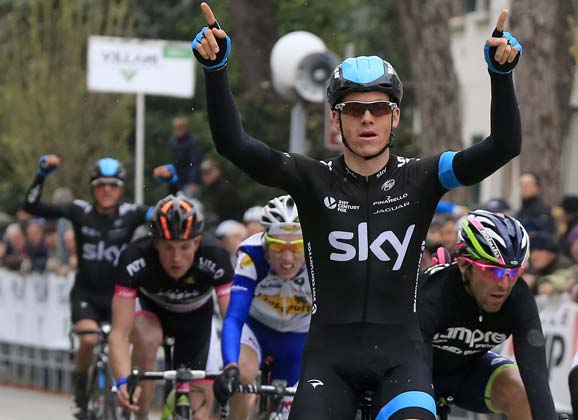Not so long ago Ben Swift was just another rider in the British development program. Early in the 2014 season, he’s winning alongside others who were part of the system that was managed by the likes of Rod Ellingworth. At the recent Coppi/Bartali Week, Swift picked up two wins on day one: a road stage, followed by a team time trial together with British Sky team-mate Peter Kennaugh who went on to win the overall title.
A few days before his first win of the year, the 26-year-old stood on the podium of Milan-San Remo. It was his debut in the Italian Classic and he finished third behind Alexander Kristoff and Fabian Cancellara.
RIDE caught up with Ben Swift to talk about that race, the season thus far, and what we can expect from him as the year progresses… here is a transcript of that exchange.
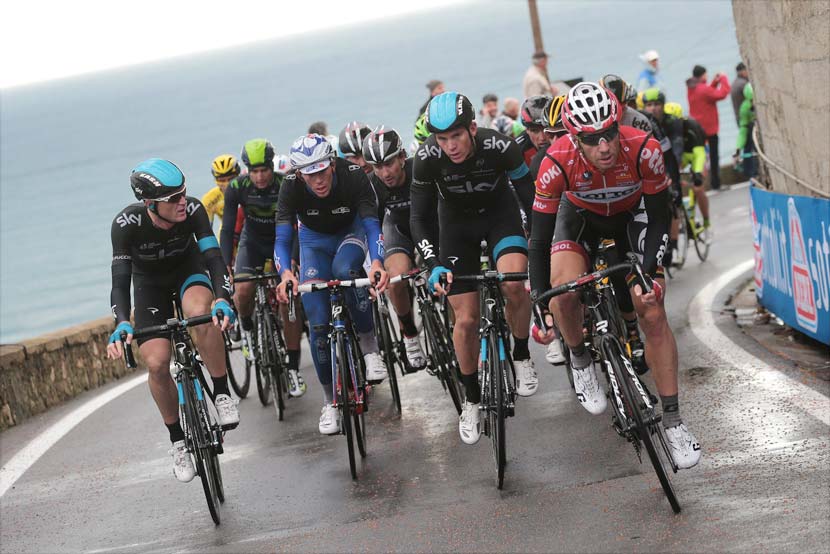
Salvatore Puccio and Ben Swift of Team Sky near the front of the peloton up and over the Poggio in Milan-San Remo.
Photo: Yuzuru Sunada
Ben Swift Q&A: “I was like, ‘Here we go – this is it!'”
– Interview by Rob Arnold (3 April 2014)
RIDE: Let’s rip straight into it and talk about your third place in Milan-San Remo. It’s not often that one gets to stand on the podium at one of cycling’s true Classics.
Ben Swift: “It’s the first time I’ve been on the podium of a WorldTour race since a stage of the Tour of Poland in 2012. That was my last victory before Coppi/Bartali.
“Milan-San Remo was incredible really. I only got the nod to ride two weeks beforehand, once they changed the route. It’s been a race that has suited my characteristics for a long time but I’ve never actually raced it before; I’ve either been injured or on the track. I’ve never been in competition [on the road] in March before so it was really nice to go there and get a good result.”
What was the set-up with others on the team like Edvald Boasson Hagen. Was he working for you or was it going to be a combo…?
“Yeah, it was kind of an interesting one. Going into the race, we had Geraint Thomas and Edvald as our leaders. ‘G’ was going to follow the moves and go with the attacks on the climbs – and maybe try something himself. And Eddy was just going to assess the situation and see what was happening on the Poggio and then go for the sprint at the end.
“I kind of had a ‘protected’ role. I wasn’t a leader; I was next in the rank… and then G was having some problems. I was feeling good on the Cipressa, and it was there that Eddy came up to me and asked me how I felt and I told him, ‘I’m feeling pretty good.’ So we discussed it again and agreed that he’d follow any moves and that I’d go for the sprint. We finished off the plan out on the road a little bit.”
The image of the finish shows you on the left side of the road and a team-mate [Salvatore Puccio, who finished 12th] quite a bit further back on the other side of the road. Was there a lead-out for you at all?
“Yeah, Puccio rode on the climbs for me: he was ahead of me until the bottom of the Poggio and up the climb. By the time that it had all come back together again, he was too far back and I was just kinda following [Peter] Sagan at the finish.”
That in itself sounds like an interesting thing to do. Sagan has proven that he’s a great bike handler. How was it going down the Poggio in those conditions? It was pretty horrendous weather, did you have your wits about you?
“Oh definitely. I’d only ridden the Poggio descent once before. When I was based in Nice last year, I went over in the car and we recorded it – we filmed the Cipressa climb and descent, and the Poggio climb and descent. It allowed us to really have a good look at it.
“Once I knew that I was going to do the race, I really had another good look at the footage and I remember saying to my girlfriend and my family, ‘If I’m anywhere near the front of the race at that moment, you’d be better off not looking because Milan-San Remo is a race where you put everything on the line to stay with the front group…’
“I actually went over the top of the Poggio in fourth place and had a moment to myself when I was like, ‘Here we go – this is it! These are dangerous conditions and you’ve just got to take it as it comes.’ And I actually felt really comfortable going down there. I noticed a few people attacking but I was just going really well.”
What tyres did you use that day?
“We used our normal Veloflex tubulars.”
Were they big fat ones like is the trend of late?
“They were just the standard ones, I think. It’s about 23 – and then we use 25 on the rougher conditions.”
Going down the Poggio on a wet road, did you find that you were sliding into corners – was there any moment when you thought, ‘Oh, I’ve pushed it too hard…’
“No, not really. I was pretty calm and collected and in control really. I had one slide at one point when I was coming into a corner a bit too hot but you get used to that a little bit really.
“You’ve just got to look around the corner and be prepared for what’s coming up.
“It’s more dangerous if there’s a little stream of water running across the road. Up there on a day like that, there are a lot of puddles on the road and that makes it a bit more slippery but it’s just par for the course. I’m used to it.”
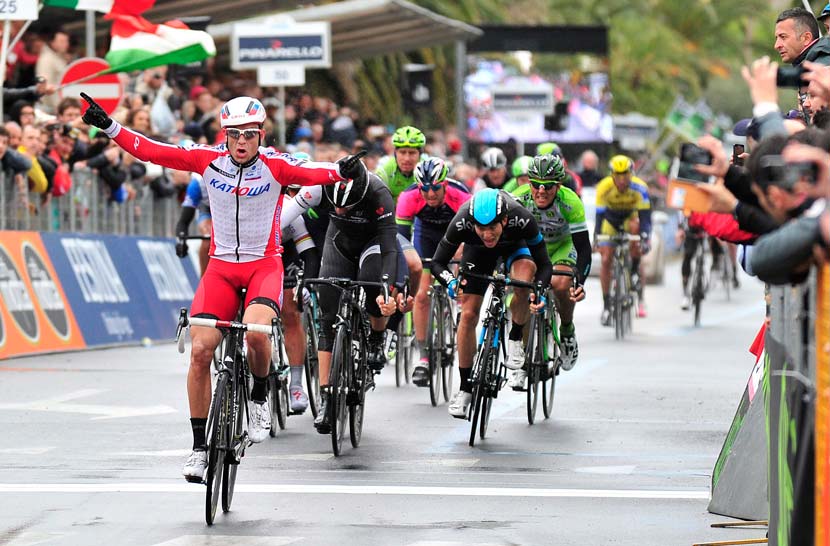
Alexander Kristoff wins Milan-San Remo with Fabian Cancellara second and Ben Swift third…
Photo: Graham Watson
Third in a Monument – that’s the first time you’ve done that. Does it add up in your mind when you’re on the podium and equate to what you imagined it might be like?
“Erm, on the podium I was a little bit overwhelmed really because it was so unexpected. I obviously knew that I was feeling pretty good – I had done some good training going into it – but when you only get put into a race like that at the last moment, and it being such a big race, it’s always a pleasant surprise to get a nice result like that.
“It reminds me that it’s a race I can target in the future, depending on if they put this new climb in or not.”
Are your track days behind you?
“No, I don’t think so. Before the London Olympics, I thought that was it – that I’d finished on the track, but I trained a lot on the track this winter after my shoulder injury and I just love the track. It’s a part of me that will never go away. Whether or not I do an Olympics again, I’m not sure but the world championships and stuff like that – when I can do it, when I can actually put time aside to do it – I’d really like to be there.
“Hopefully, one day, I’ll turn some of those silvers into golds.”
After Milan-San Remo, you go to Coppi/Bartali and immediately win a stage. Obviously the work you did on the track is paying off on the road.
“Yeah, definitely. I’m coming into some nice condition now.
“It was cool at Coppi/Bartali because it was almost like an academy feel to it; there was me and Pete Kennaugh there – it was quite a young team. We had Rod [Ellingworth] with us. We had no bus or anything, it was just a small camper – and it was nice, it just felt like we were going back to the academy days. The atmosphere of the race was very similar and we performed really well: I got my stage win, we won the team time trial and Pete won the next day. It was just amazing to be part of and obviously the morale and the momentum is running high in the team.”
Often when Mark Cavendish opens up his sprint, that’s it – everyone else is racing for second place. But it was different in Milan-San Remo this year. Have you spoken to him about that sprint?
“No, we’re on rather different programs and I’ve only raced with Cav twice this year so I haven’t seen much of him.
“The biggest factor there was the weather – it was really, really cold and it affected a lot of people. It affected Sagan; he didn’t have his normal sparkle. If you follow Sagan, it’s normally a pretty good wheel to follow… but he just didn’t have anything at the finish. The conditions affected a lot of people.”
Coming into the sprint, it seemed chaotic because there was no dominant team. As a sprinter, does that make it more enjoyable or frustrating? Does it feel a little more like a track environment – as though it’s more like a points race or scratch race with little or no allegiances?
“That’s exactly what it felt like to me, like I was in a track race. We’d done over 290 kilometre and then the last two kilometres was like being back on the track. There were people spread all over the road. There were small attacks going in different moves… and not a lot of teams had more than two riders. It was a completely different feel to usual and it does get a bit choppy. The corners help sort it out but you’ve kinda got to be wary of the turns because they’re off-camber and they’re soaking wet, and everyone is cold, so you’ve just got to play with the conditions.”
Apart from achieving a result, is there a moment in a race like that when you have a bit of a grin and think, ‘This is actually really good fun…’?
“Oh definitely! I love it when it’s like that. When I knew that I had good legs on the Cipressa and the Poggio it was great. Normally, at a point like that, you’re just grimacing and holding on… but I felt really in control and able, within myself, to stay quite comfortable. And you can definitely enjoy it a lot more when it’s like that.
“Then, down into the finish, it’s exciting because you know it’s one of the biggest races in the world and it pans out like it did…
“Milan-San Remo, it’s such a strange race. There were 28 guys in the front group, you know, and half of them were sprinters… I just can’t get my head around it – how the dynamic of the race works.”
We know how it works: there’s that real giddy-up with the battle for position on the approach to the Cipressa. As a first-timer in the race, did it feel like you were racing on Playstation – as though you were racing roads you knew from the screen. Like it was something you’d seen a lot and now you were part of it?
“Yeah, definitely. It was in a long line all day really. Once you hit those little climbs on the coast, that’s when the rain capes come off and it’s almost like go time. It is a strange race to ride and watch. As you say, you can go through the motions for over 200km and, all of a sudden, in the last 60-odd kilometres someone just pushes a button and it all explodes.”
And when you’re in the lead group you’d be glancing behind realising that the group is thinning out rapidly. Was there a moment when you thought, ‘Oh, I’m not going to hold this selection’? You must’ve been thrilled just to have crested the Poggio in fourth…
“It’s easy to make mistakes in times like that. If you feel like you have good legs, it’s easy to do stupid things. But I felt like I rode really sensibly and within myself. I got into good position, rode up the Cipressa, felt good up there, and then that gave me the confidence then to know that I was going pretty well for the Poggio.
“On the Poggio I was just trying to watch and assess and I even thought about putting in a little attack myself. But that’s a stupid thought – like one you get to when you know you have good legs. I knew that my best option was to wait for the sprint and so I moved up the outside and got into a really good position for the descent, so just being there on the climb gave me a lot of confidence.”
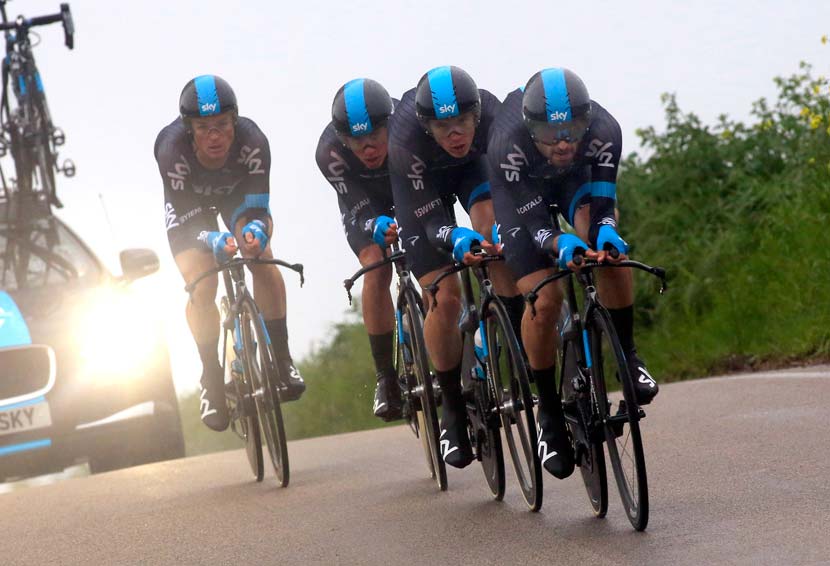
On the road to victory in the Coppi/Bartali TTT… Cataldo leads Swift, Kennaugh and Kiryienka.
Photo: Graham Watson
* * * * *
I think we’ve examined Milan-San Remo pretty well, so let’s move on.
I know that, in the early days of Sky, there was a strong focus on refining process and technique. Greg Henderson, for example, explained that when he joined the team in the inaugural year he was doing training to sprint aerodynamically. After a few years in the peloton, is the team still getting into those details? Are you trying to get low in a sprint – that sort of thing?
“Err, not particularly – no. I’m just doing my sprint training really. On the track we ride pretty low anyway and sprint with a low position so I’ve never really worked, as such, on my aerodynamics.
“I like mixing my training up. I was using the motorbike a lot on the track just because I feel like, when I sprint, I can kind of get up to speed and hold it well. I was playing with the idea of how I could do that.
“When you sprint on the track, you are normally sprinting for 250 or 350 metres – like a lap-and-a-half or a lap to go. And using the track to refine my sprint is a massive benefit.
“That Milan-San Remo sprint is not indicative of how things usually are. There were men here, there and everywhere. Perhaps I just chose the wrong line. In hindsight, I’d have done it a different way but looking at things retrospectively is how I can improve.”
What wattage did you put out in the sprint in Milan-San Remo?
“I didn’t hit a lot of Watts actually, I only just hit over 1,000. I’m not sure what Kristoff hit: he had a nice clean sprint and I don’t think many people hit a great number of Watts after nearly 300km in those conditions.”
What’s going to happen for you for the rest of the year – is the Vuelta the priority for you?
“Yeah, a little bit. I guess it’s the priority for the second half of the year. My big target in the first half is Tour de Suisse, I’ve been close there a lot over the years. I’ve had seconds, thirds… quite a few of them and I’d really like to turn one of those into a stage win. That’s a big target of the year.”
Do you call yourself a ‘veteran’ of the peloton now. Where are you at in the scheme of things? Do you feel established?
“It’s getting pretty scary to be honest – I’m no longer one of ‘The Young Guys’ in the team anymore. There was a realisation at one of the races this year when I looked around and realised I was the eldest in the team. It all goes pretty quick.”
Where did you grow up and get your introduction to cycling?
“In Sheffield. Actually stage two of the 2014 Tour de France, the last 50km are on all the roads that I know really well – that’s where I trained on when I was young, and still train on now when I go back. That’s where my family is.”
So, can we segue to that stage of the Tour de France and get your appraisal – and perhaps get you to tell us now who is going to win that stage…
“Well, I can give it a good go… It’s going to be brutal. It’ll be a bit of a surprise how hard it’s going to be especially if the weather is playing up a bit – if it’s wet, cold and windy which it can be at that time of the year over the Moors. It’s barren. It’s really open and there’s no much there.
“Obviously, it’s the Tour de France and there’s going to be a lot of spectators. Actually, the only reason that it might not be as broken up as it might usually be is because it’s the biggest bike race in the world and everybody is on their A-game. Even so, it’s going to such a good race to watch. It’s almost going to be like a mini-Ardennes race. It’s not cobbles, but the roads are not great. It’s open, windy, up and down… it should be a great race to watch, I think.”
And the winner?
“That’s an interesting one; I think someone like Peter Sagan. To be honest, it’s perfect terrain for him.”
Just quickly, with the Tour of Flanders on the horizon this coming Saturday… it’s been a fairly shocking week for Sky with Stannard and CJ Sutton smashing themselves up a bit. Was there any talk of you maybe going into the Flemish Classics?
“No, I said right from the off that I didn’t want to do the cobbled Classics this year – especially as my shoulder has had a bit of a battering these last few years. I just want to target races that really suit me and just get back to the rider that I used to be.
“I did the Vuelta al Pais Vasco in my first season as a pro and every day there was a sprint there, I won the bunch sprint – but there was always a breakaway away so I got some minor places…
“It’s in races with shorter, sharper climbs that I can perform a bit and unfortunately that clashes with the cobbled Classics.
“Hopefully, in the future, I’ll return to the cobbled Classics but this year I want to ‘return to my roots’ and get into the big, long stage races.”
– Interview by Rob Arnold
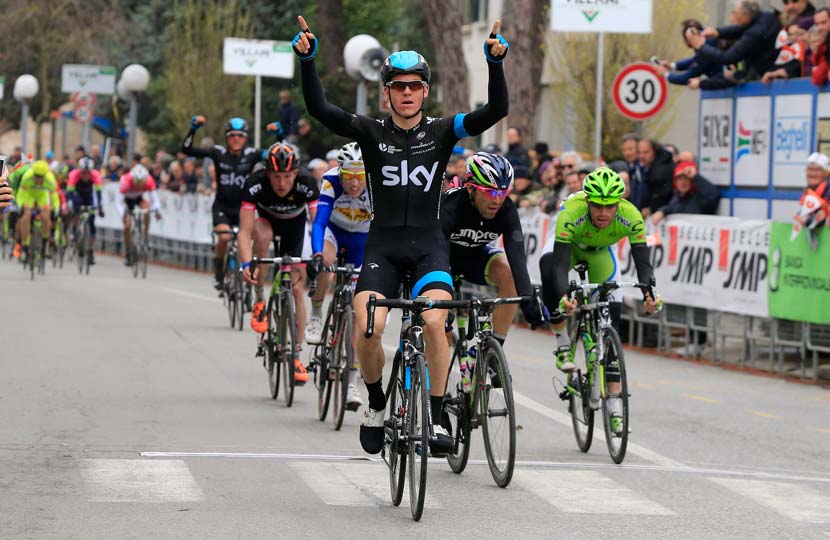
Ben Swift, first in stage one of the Coppi/Bartali Week… his first victory since the 2012 Tour of Poland.
Photo: Graham Watson.


